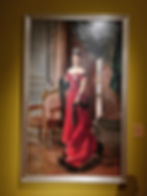Exhibition: Court Uniform and Dress (Moscow, 2021)
- Katerina
- 5 июл. 2021 г.
- 4 мин. чтения
Ahead of the 150th anniversary of the Historical Museum (Moscow) founding that will be celebrated in 2022, The State Hermitage made a generous gift - gave garments from their collection to the exhibition "Court uniform and dress of the mid-19th - early 20th centuries".
The exposition is dedicated to the ceremonial and everyday life of the Russian Court, which was influenced by both the West and the Orient but always remained truly and unmistakably Russian.
The exhibition presents about 50 dresses: ceremonial and everyday dresses, ensembles worn for visits and promenades, children's and masquerade costumes, morning, evening and ball gowns, military uniform and liveries, which were made in the most famous fashion ateliers in Paris, London, Saint Petersburg, Moscow, Warsaw.
Ceremonial court dress of a lady-in-waiting to the Empress. Saint Petersburg, workshop of Olga Bulbenkova. Late 19th century - early 20th century.

Peter the Great made a public carnival on January 1 at the imperial residence traditional. After the fire in 1837, in the Winter Palace, public masquerades there were no longer held, but they continued at the Bolshoi Theater and the Assembly of the Nobility, on Maslenitsa - twice a week. In St. Petersburg were famous masquerades, which took place in the Anichkov Palace, where members of the imperial family lived and where only a select audience gathered, in the grand-ducal palaces and mansions of the capital's aristocracy. In the second half of the 19 century, large fancy-dress parties were a rarity at the highest court.
In the exhibition are two dresses worn by Countess Sofia Genrikova and Princess Zinaida Yusupova at a luxurious fancy-dress party with "tableaux vivants" (live paintings) organized by Grand Duchess Ekaterina Mikhailovna at the Mikhailovsky Palace on April 10, 1890. All the participants in the ball appeared in costumes that seemed to have come down from the canvases of Venetian artists of the 16th-17th centuries.
Fancy Dress of countess Sofia Gendrikova. Saint Petersburg, workshop of A. Ivanova. 1890.

Fancy Dress of Princess Zinaida Yusupova. Saint Petersburg, workshop of A. Ivanova. 1890.

One of the sections of the exhibition is devoted to the life of the imperial family - Alexander III and Maria Feodorovna, who was the trendsetter among the ladies of the high society.
Evening (visiting) dress of Empress Maria Feodorovna. Paris, Charles Worth fashion house. 1892-1893.

Evening (visiting) dress of Empress Maria Feodorovna. Paris, Charles Worth fashion house. 1893.

Visiting dress of Empress Maria Feodorovna. Saint Petersburg, workshop of A. Ivanova. 1888.

Evening dress of Empress Maria Feodorovna. Paris, Charles Worth fashion house. 1892-1894.

There are presented home and morning clothes, linen, and personal belongings of the emperor and empress in a separate exhibition area.
Tea gown of Empress Maria Feodorovna. Paris, Laferriere fashion house. 1892-1893.

Home dress of Empress Maria Feodorovna. Russia (?), circa 1890.

At the exhibition, you can see more than 60 accessories that belonged to Russian emperors and empresses, members of the imperial family, representatives of aristocratic families, court ladies and gentlemen, servants of the Imperial Court of the time of the last Romanovs.
Shoes of Empress Maria Feodorovna:
Handkerchief of grand duchess Maria Feodorovna. Russia, 1866.
In two opposite corners in white satin stitch - the names Maрiя (Maria) and Александръ (Alexander), in the other two in white stitch - the dates 1866 September 14 (the day of Maria's arrival to Russia) and 1866 October 28 (the day of their marriage). The dates are in the old style. The headscarf was presented to Grand Duchess Maria Feodorovna on the occasion of her marriage to Grand Duke Alexander Alexandrovich.

Stockings of Empress Maria Feodorovna:


Hat of Empress Maria Feodorovna. France (?), early 1880s.

Unlike Maria Feodorovna, who adored court celebrations, military parades, diplomatic receptions, performances, masquerades, dances, the emperor avoided publicity and preferred military uniforms to all clothes. The exhibition also presents the costumes of the servants of the imperial court: chamber-furriers, valets, walkers, court moors.
Ceremonial dress of a court blackamoor: coat, waistcoats, trousers, sash, gaiters, shawl, shoes. Saint Peterburg, firm of I.P. Lidval. 1912-1913.

Also at the exhibition, you can see works of painting and graphics, archival documents, samples of weapons, items made of precious metals. Portrait of Grand Duchess Maria Feodorovna, 1874. Heinrich von Angeli.
The painting was painted in the autumn of 1874, in Livadia, where Heinrich von Angeli, who was then at the zenith of fame, was invited. Maria Feodorovna gave this portrait to her husband for Christmas 1875, since then the painting has not left the office of Alexander III in the Anichkov Palace. It entered the Hermitage collection only in 1932.

Portrait of Empress Maria Feodorovna, 1894. Francois Flameng.

Portrait of Princess Zinaida Yusupova, 1894. Francois Flameng.

The last hall of the exhibition demonstrates wedding dress of Grand Duchess Alexandra Feodorovna. Saint Petersburg, workshop of Olga Bulbenkova. 1894.
The bride's dress consisted of three parts - a bodice, a lower, and an upper skirt. The image with a long train was made of silver-gray brocade and had long and wide fold-over sleeves decorated with white marabou down, lace, and embroidery with lilies. Despite the fact that the dress looks quite lush and airy, the dress weighs almost 10 kilograms. The luxurious silver outfit was also accompanied by a golden robe with ermine trim which weight was 13 kilograms.
The wedding ceremony of Nicholas II and Grand Duchess Alexandra Feodorovna on 14 November 1894, 1895. Laurits Regner Tuxen.

If you have not yet visited the exhibition, you can do it before July 16, 2021.

















